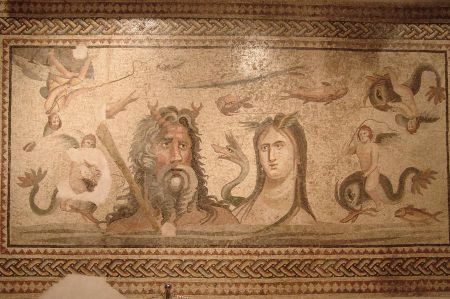Doliche - Christian basilica and bath discovered in Turkey
- Written by Portal Editor
Older Near Eastern roots indicate the shape of the northern Mesopotamian weather god Hadad, Babylonian Adad, who was depicted standing on a bull with a double ax and a lightning bolt.
The scientific exploration of the ancient landscape Commagene is traditionally one of the central tasks of the research center Asia Minor, several times we had already reported about the excavations on site. With the discovery of two Mithräen at the foot of the ancient settlement hill of Doliche in the years 1997 and 1998, this city moved into the center of the excavation work. Since 2001, archaeological research has concentrated on the central sanctuary of Iuppiter Dolichenus, which is located near the ancient city. Since 2015, the ancient city of Doliche has once again become the focus of research interest. By means of targeted excavations, both the ancient residential buildings and public areas of the city are to be investigated, and thus new insights into urban development in Hellenistic-Roman Syria are to be gained paradigmatically.
Doliche - Episcopal view after place of worship of Syrian Baal
The ancient village of Doliche was a significant place of worship of the Syrian Baal. After the conquest of the city and the incorporation into the province of Syria in the last third of the 1st century AD by the Romans, the cult was transferred to Jupiter and spread as a soldier god Iupiter Dolichenus throughout the Roman Empire. After the destruction of the main sanctuary in Doliche by the Sassanid king Shapur I. mid of the 3rd century AD, the cult went down. The city persisted, however. With the flowering of Christianity, a basilica was built. The city became a bishopric. It continued to be a military and administrative center of the region after the 7th century Arab conquest.
Excavations secure bath three-aisled basilica
Archaeologists have now released valuable baths from the 2nd or 3rd century AD in the ancient city of Doliche near the Syrian border. The bath was no longer in operation from the 4th century, it was said in archaeological circles. With about 2,000 square meters, the bath had been of considerable size, it was said at the end of the last excavation season. It shows the typical sequence of cold, warm and hot baths for the Romans. An approximately 150 square meter space with swimming pool and the heating system / hypocaustics under the floor could be uncovered.
The discovery of the three-aisled basilica represents a special opportunity, the researchers explained. Because in this region, which is so important for early Christianity, only a few inner-city church buildings are archaeologically researched. In this year created search cuts would have brought especially ancillary rooms and annexes of the church complex to light.
Archaeologist Winter from the Research Center Asia Minor reports
 Thus the plant was much more extensive than expected. "Their further exposure promises to significantly extend the knowledge of religious life and sacral architecture in late antique of northern Syria," said Winter. Other finds showed that the church was probably destroyed by an earthquake in the 7th century. The city was abandoned in the 12th century.
Thus the plant was much more extensive than expected. "Their further exposure promises to significantly extend the knowledge of religious life and sacral architecture in late antique of northern Syria," said Winter. Other finds showed that the church was probably destroyed by an earthquake in the 7th century. The city was abandoned in the 12th century.
In addition to Doliche and the sanctuary other projects are the processing of finds from the necropolis of Perrhe, the Hellenistic-Roman inscriptions from the Museum Adiyaman and cultural studies in northern Commagna.
The Research Center Asia Minor of the University of Münster is digging in the main shrine of the Iupiter Dolichenus with the support of the German Research Foundation (DFG). The researchers released findings from all epochs of the 2,000-year history of the place of worship until 2016.
"Doliche is ideal to exemplify the cultural, political and religious development of a city in ancient Syria. Their further exposure promises to significantly extend the knowledge of religious life and sacral architecture in late antique northern Syria, "said Winter, Archaeologist Asia Minor.
Please read as well:
Sanliurfa - known as ancient Edessa
Göbekli Tepe "Potbelly Hill" - 11000 years old sanctuary